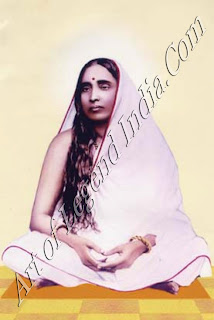Yoga
An
evolved Sanyasi, however, is also usually a Yogi. The word Yoga means to yoke
or unite, and it is used to imply the means or path by which the individual
soul unites with God.
Yoga is
today confused with physical exercises alone. Actually it includes eight types
of disciplines.
The
first two yama and niyama purify the heart and bring about ethical discipline.
Yama means abstention of all types’ abstention from killing, untruth, theft and
possession of property. It also means the practice of celibacy. Niyama means
observance of purity (both external and internal) and practice of austerities
or tapasya. It includes supreme contentment, thestudy and knowledge of the
scriptures and surrender to the Supreme God.
The
next three, asana, pranayama, and pratyahara are preliminary steps to Yoga.
Asanas are the Yogic postures which, when practised regularly, steady the mind
for concentration and discipline the body. Pranayama are breathing exercises
which improve the condition of the lungs, heart and nervous system, bring about
good health and thereby give a tremendous sense of well-being. They also result
in serenity and steadfastness of the mind without which Yoga is meaningless.
Pratyahara means shutting out all outward impressions from the mind and looking
inward.
 The
last three steps are called Raja Yoga and include dharana, dhyana and samadhi.
Dharana means concentration on any one object which could be a light within the
mind or a form or image of God used in prayer. Then comes dhyana or meditation
involving an unceasing flow of thoughts and ideas towards this object. Such
meditation leads to the final state known as samadhi, when the subject of the
meditation and the object become one.
The
last three steps are called Raja Yoga and include dharana, dhyana and samadhi.
Dharana means concentration on any one object which could be a light within the
mind or a form or image of God used in prayer. Then comes dhyana or meditation
involving an unceasing flow of thoughts and ideas towards this object. Such
meditation leads to the final state known as samadhi, when the subject of the
meditation and the object become one.
Samadhi
itself involves two steps. The first is conscious samadhi when the Yogi attains
supernatural powers by the strength of his Yogic practices, becomes
clairvoyant, adept at mind-reading and thought-transmission. These powers,
called siddhis, are looked down upon in Yoga, but unfortunately most Sanyasis
never go past this stage. At the same time unevolved persons and the illiterate
masses are completely taken in by such persons because they appear to perform
miracles, promise to cure diseases and to bring material prosperity to those
devoted to them. Such Sanyasis should be guarded against.
The
Sanyasi who ignores such powers and progresses further attains the
superconscious or nirvikalpa samadhi when the mind is in full union with God.
The Yogi in this stage has broken the bonds of Samsara, the cycle of births and
deaths and is verily a liberated soul.
 From
time immemorial great Yogis and Sanyasis have been Gurus (or teachers) who have
taught the truths of the Hindu religion and spread its messages to the masses
and to intellectuals, to guide them in matters of the spirit. Some of them have
spread these truths all over the world.
From
time immemorial great Yogis and Sanyasis have been Gurus (or teachers) who have
taught the truths of the Hindu religion and spread its messages to the masses
and to intellectuals, to guide them in matters of the spirit. Some of them have
spread these truths all over the world.
Shri
Ramalinga Swami, Shri Ramakrishna Paramahamsa, Sharada Devi, Swami Vivekananda,
Swami Rama Tirtha, Shri Aurobindo, Shri Ramana Maharishi and Swami Sivananda
are a few of the many great souls no longer with us whose spiritual messages,
loud and clear, still guide mankind. Hundreds of Hindu Yogis and Sanyasis are
to be found all over the world today who work for the spiritual progress of our
great land. Whereas there are quite a few who trade on the gullibility of the
innocent, there are several genuinely great Gurus who teach those amongst us
who are totally ignorant about our own religion and guide others towards the
path of spiritualism. To such Sanyasis and their work of spreading the truths
of the Hindu Religion, we should bow in all humility.
Writer
–Shakunthala Jagannathan
 The
last three steps are called Raja Yoga and include dharana, dhyana and samadhi.
Dharana means concentration on any one object which could be a light within the
mind or a form or image of God used in prayer. Then comes dhyana or meditation
involving an unceasing flow of thoughts and ideas towards this object. Such
meditation leads to the final state known as samadhi, when the subject of the
meditation and the object become one.
The
last three steps are called Raja Yoga and include dharana, dhyana and samadhi.
Dharana means concentration on any one object which could be a light within the
mind or a form or image of God used in prayer. Then comes dhyana or meditation
involving an unceasing flow of thoughts and ideas towards this object. Such
meditation leads to the final state known as samadhi, when the subject of the
meditation and the object become one.  From
time immemorial great Yogis and Sanyasis have been Gurus (or teachers) who have
taught the truths of the Hindu religion and spread its messages to the masses
and to intellectuals, to guide them in matters of the spirit. Some of them have
spread these truths all over the world.
From
time immemorial great Yogis and Sanyasis have been Gurus (or teachers) who have
taught the truths of the Hindu religion and spread its messages to the masses
and to intellectuals, to guide them in matters of the spirit. Some of them have
spread these truths all over the world. 











0 Response to "Introduction to Yoga"
Post a Comment